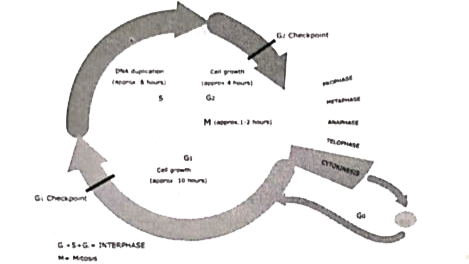List the different phases of a cell cycle.Solution in Tamil
The different phases of cell cycle are as follows:
Interphase: Longest part of the cell cycle, but it is of extremely variable length. At first glence the nucleus appears to be resting but this is not the case at all. The chromosomes previously visible as thread like structure, have dispersed. Now they are actively involved in protein synthesis, at least for most of the interphase.
C-Value is the amount in picograms of DNA contained within a haploid nucleus.
G1 Phase: The first gap phase - 2C amount of DNA in cells of G1 . The cells become metabolically active and grows by producing proteins, lipids, carbohydrates and cell organelles including mitochondria and endoplasmic reticulum. Many checkpoints control the cell cycle. The checkpoint called the restriction point at the end of G1 , it determines a cells fate whether it will continue in the cell cycle and divide or enter a stage called as a quiescent stage and probably as specified cell or die. Cells are arrested in G0 due to:
Nutrient deprivation: Lack of growth factors or density dependant inhibition Undergo metabolic changes and enter into G0 state.
Biochemicals inside cells activates the cell division. The proteins called kinases and eyelins activate genes and their proteins to perform cell division. Cyclins act as major checkpoint which operates in G1 to determine whether or not a cell divides.
G0 Phase: Some cells exit, and enters a quiescent stage called G0, where the cells remain metabolically active without proliferation Cells can exist for long periods in G0 phase. In G0 cells cease growth with reduced rate of RNA and protein synthesis. The phase is not permanent. Mature neuron and skeletal muscle cell remain permanently in G0. Many cells in animals remains in G0 unless called on to proliferate by appropriate growth factors or other extracellular signals. G0 cells are not dormant.
S Phase-Synthesis phase-cells with intermediate amounts of DNA.
Growth of the cell continues as replication of DNA oscur, protein molecules called histones are synthesised and attached to the DNA. The centrioles duplicate in the cytoplasm. DNA content increases from 2C to 4C.
G2 - The second Gap phase- 4C amount of DNA in cells of G2 and mitosis Cell growth continues by protein and cell organelle synthesis, mitochondria and chloroplasts divide. DNA content remains as 4C. Tubulin is synthesised and microtubules are formed. Microtubules organise to form spindle fibre. The spindle begins to form and nuclear division follows.
One of the proteins synthesized only in the G2 period is known as Maturation Promoting Factor (MPF). It brings about condensation of interphase chromosomes into the mitotic form.
DNA damage checkpoints operates in G1, S and G2 phases of the cell cycle.

Topper's Solved these Questions
- SAMPLE PAPER-4 (SOLVED)Book:FULL MARKSChapter:SAMPLE PAPER-4 (SOLVED)Exercise:Bio-Zoology(Part-I)
Explore 8 Videos
- SAMPLE PAPER-4 (SOLVED)Book:FULL MARKSChapter:SAMPLE PAPER-4 (SOLVED)Exercise:Bio-Zoology(Part-II)
Explore 6 Videos
- SAMPLE PAPER-4 (SOLVED)Book:FULL MARKSChapter:SAMPLE PAPER-4 (SOLVED)Exercise:Bio-Botany(Part-III)
Explore 5 Videos
- SAMPLE PAPER-10 (SOLVED)Book:FULL MARKSChapter:SAMPLE PAPER-10 (SOLVED)Exercise:ZOOLOGY (PART-IV)
Explore 4 Videos
- SECONDARY GROWTH Book:FULL MARKSChapter:SECONDARY GROWTH Exercise:Higher Order Thinking Skills (HOTs)
Explore 5 Videos
Similar Questions
Turbellarians are free living ............ .
View SolutionWhat is radial symmetry?
View SolutionState the 3 types of viral symmetry,
View SolutionDifferentiate Chordates and Non-Chordates.
View SolutionWhat do heart wood and sap wood stand for ?
View SolutionFour phases of cell cycle are
View Solutionअन्तरावस्था से संबन्धित कोशिका चक्र के विभिन्न चरणों के नाम बताइए तथा महत्त्व का वर्णन कीजिए ।
View SolutionWhat is Cell Cycle? Mention the phases of Cell cycle.
View SolutionLongest phase of cell cycle is :-
View Solutionকোশচক্রের বিভিন্ন দশা ছকের সাহায্যে দেখাও ৷
View SolutionCell Cycle | Phases Of Cell Cycle | Introduction
View Solutionनीचे कोशिका चक्र की प्रावस्थाओं/अवस्थाओं का योजनाबद्ध विभाजन दिया गया है

निम्न में से कौन सा कोशिका चक्र में अवस्था/प्रावस्था का सही सूचक है
View SolutionIn cell cycle, the different phases are in which order:
View SolutionCell in G_0 Phase of cycle cell
View SolutionWhat are different phases of cell cycle ?
View SolutionThe cell cycle consists of....................phase.
View Solution

